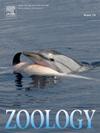Embryonic behavior and skeletogenesis in developing skate Okamejei kenojei
IF 1.6
3区 生物学
Q2 ZOOLOGY
引用次数: 0
Abstract
Cartilaginous fishes (sharks, skates and chimaeras) exhibit diverse behavioral patterns and unique endoskeleton, which provide insights into their ecological adaptations and evolution. However, research on the development of cartilaginous fish is still limited. To evaluate the relationship between embryonic behavior and cartilage development in cartilaginous fishes, the developing Okamejei kenojei was analyzed through behavioral, anatomical, and histological approaches, with an atlas of embryonic behavior and skeletal morphology. The result shows that the behavior of skate embryos evolves from early rhythmic movements to vigilance behavior to external stimuli. Data from Alcian blue and Alizarin red staining and histology sections showed that the vertebrae are the earliest regions to mineralize, with the mineralization process starting at the neural arch area and expanding along the body axis. In the anterior area, mineralized structures spread along the synarcual and neurocranium towards the pectoral fins and fin rays. Interestingly, a novel branching pattern of fin rays was observed in the pectoral fins of embryonic O. kenojei, characterized by the inward growth of the perichondrium into the cartilage element, potentially linked to the morphogenesis of the skate's pectoral fins. Additionally, this study provides a set of open-source morphological data for O. kenojei, which will serve as a valuable reference for marine animal conservation and evolutionary developmental biology.
滑鱼发育过程中的胚胎行为和骨骼发生
软骨鱼类(鲨鱼、冰鱼和嵌合体)表现出多样化的行为模式和独特的内骨骼,这为他们的生态适应和进化提供了见解。然而,对软骨鱼类发育的研究仍然有限。为了研究软骨鱼类的胚胎行为与软骨发育之间的关系,对发育中的Okamejei kenojei进行了行为学、解剖学和组织学分析,并绘制了胚胎行为和骨骼形态图谱。结果表明,冰鱼胚胎的行为由早期的节律性运动演变为对外界刺激的警觉行为。阿利新蓝和茜素红染色及组织切片显示,椎骨是矿化最早的区域,矿化过程从神经弓区开始,沿体轴扩展。在前部,矿化结构沿椎间骨和神经头盖骨向胸鳍和鳍线扩散。有趣的是,在O. kenojei胚胎的胸鳍中观察到一种新的鳍鳍分支模式,其特征是软骨膜向内生长为软骨元素,可能与鳐胸鳍的形态发生有关。此外,本研究还提供了一套开放源代码的kenojei形态数据,为海洋动物保护和进化发育生物学提供了有价值的参考。
本文章由计算机程序翻译,如有差异,请以英文原文为准。
求助全文
约1分钟内获得全文
求助全文
来源期刊

Zoology
生物-动物学
CiteScore
3.90
自引率
0.00%
发文量
37
审稿时长
70 days
期刊介绍:
Zoology is a journal devoted to experimental and comparative animal science. It presents a common forum for all scientists who take an explicitly organism oriented and integrative approach to the study of animal form, function, development and evolution.
The journal invites papers that take a comparative or experimental approach to behavior and neurobiology, functional morphology, evolution and development, ecological physiology, and cell biology. Due to the increasing realization that animals exist only within a partnership with symbionts, Zoology encourages submissions of papers focused on the analysis of holobionts or metaorganisms as associations of the macroscopic host in synergistic interdependence with numerous microbial and eukaryotic species.
The editors and the editorial board are committed to presenting science at its best. The editorial team is regularly adjusting editorial practice to the ever changing field of animal biology.
 求助内容:
求助内容: 应助结果提醒方式:
应助结果提醒方式:


